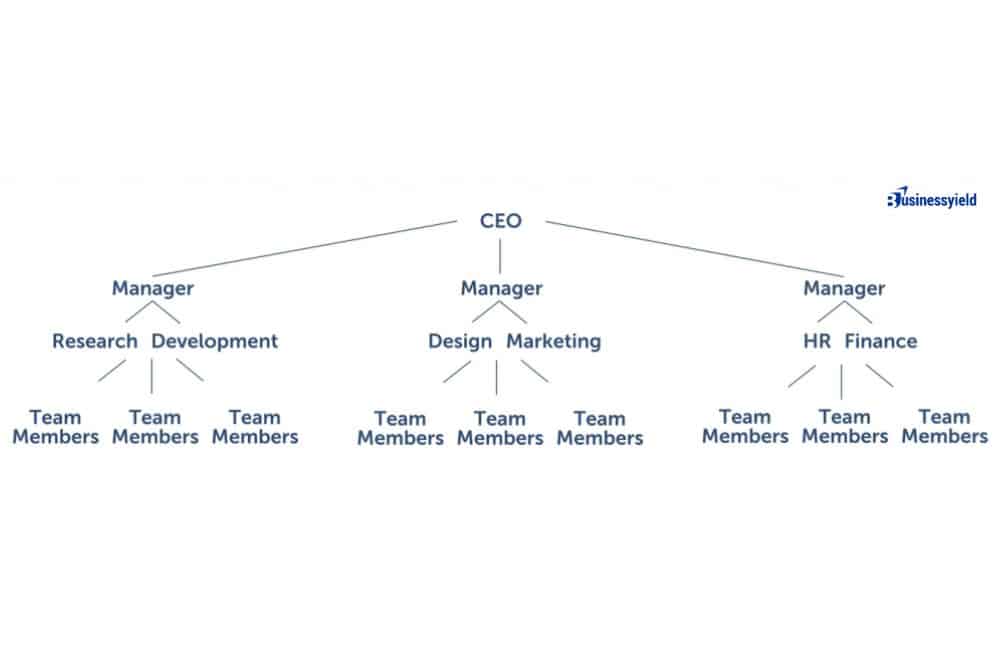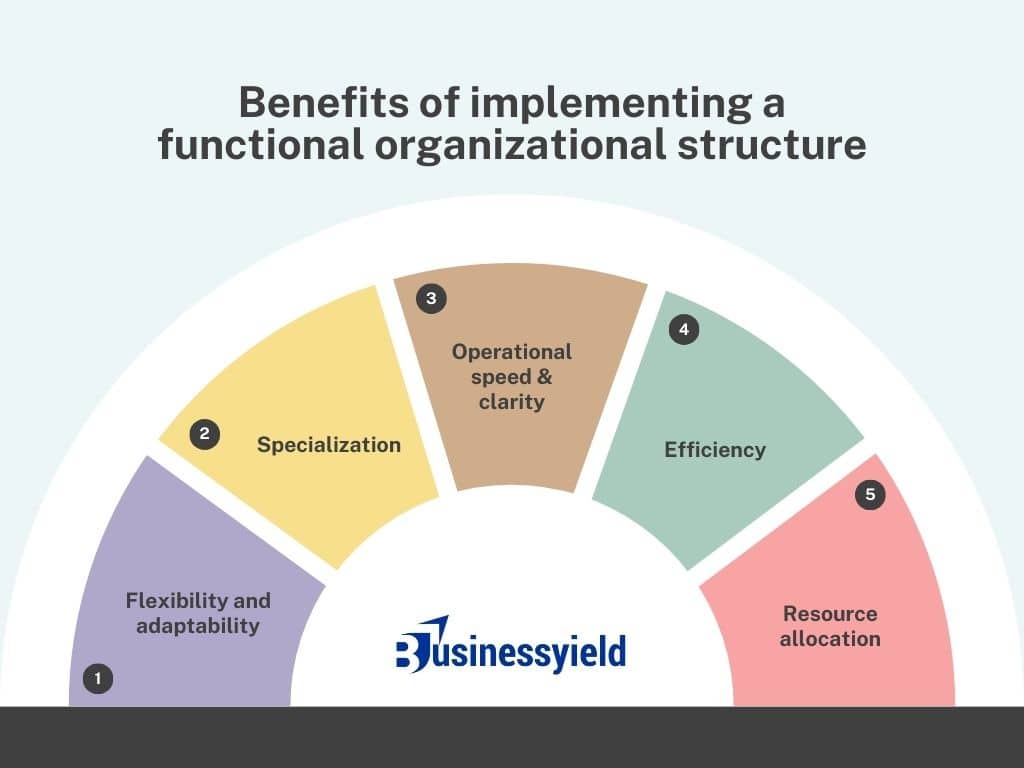Functional organizational structure is just one type of team structure but all businesses, regardless of size, need some sort of structure to operate successfully. Companies without a set organizational structure have problems implementing business policies and operating productively.
An organizational structure outlines how certain activities are directed to achieve your organization’s goals. Furthermore, it provides clear roles, routines, and ranks for workers, all of which help to improve team coordination. Without a formal organizational structure, your employees may find it difficult to know who they should be officially reporting to within the company and which managers are responsible for what.
Key Points
- A functional organizational structure organizes a company into different departments based on expertise, specialty, skill, or related roles.
- A functional organization is typically a vertical hierarchy, where employees report to a manager who oversees their function.
- Businesses commonly operate under a functional structure because it groups people who have similar knowledge.
- Large companies are the best for a functional organizational structure, as they consist of many people with the same expertise.
- One of the most significant disadvantages of a functional organizational structure is the potential for isolation from other departments.
What is Functional Organizational Structure?
A functional organizational structure is a common type of business structure that organizes a company into different departments based on areas of expertise, grouping employees by specialty, skill, or related roles. It’s based on levels of hierarchy that include different departments, under the direction of designated leaders.
In this type of organizational structure, businesses are organized according to their roles and skills into smaller groups or departments. This may include, for example:
- sales
- marketing
- production
- IT
- finance
- operations
Individuals, teams, and line managers are grouped into specialized departments where they report to the head of the department, e.g. the sales director. The business’ top management team typically consists of several functional heads, eg the chief financial officer, the marketing director, or the head of operations.
Businesses commonly operate under a functional structure because it groups people who have similar knowledge, and when used in a team environment, helps companies achieve their goals. It typically works best for larger companies that employ multiple people with similar roles. When departments have employees organized by their skills and corresponding function in the company, business owners have more time to focus on their big-picture goals while departmental heads manage their team’s goals.
SEE: A Simple Breakdown of Objectives vs Goals and How to Set Them
In smaller companies, there may not be enough employees with related skills to justify grouping them into separate departments.
Understanding the Functional Organizational Structure
A functional organization is typically a vertical hierarchy, where employees report to a manager who oversees their function. That manager may then report to another functional leadership role. For example, all employees who are responsible for sales report to the sales manager, who reports to the sales vice president. Functional departments usually operate in silos because each group has its own independent vertical management structure.
The employees within each functional department communicate with one another, instead of dealing with the employees in other functional departments. It is a key role of the management team to coordinate with other managers and flow information throughout the organization. For example, the customer service manager communicates initiatives and results with the sales, marketing and production managers.
Those managers then communicate any relevant information with their respective teams.
READ: Teamwork in the Workplace: From Benefits & Strategies to Effective Leadership
All authority, such as resource allocation, decision-making, goal-setting and budget allocation, lies with the functional manager. When an employee faces any obstacles or requires guidance, the first step is to discuss the issues with their functional manager. The manager may then opt to escalate the issue.
Companies with a functional organizational structure tend to share the following characteristics.
- There’s a top-down hierarchical structure. Most functionally structured companies have a senior management team that oversees the company at large, but nearly all other employees are part of a specific, siloed department.
- Department heads report to senior management. Each department within a company—whether it’s sales, product, or IT—has a department head who is either part of top management or directly reports to them.
- Employees specialize in certain tasks. Employees in functionally structured companies are hired for their expertise in a particular skill. They rarely stray outside of their role to help with the work of another department.
Which Type of Company is Best Suited to a Functional Organizational Structure?
Large companies are the best for a functional organizational structure, as they consist of many people with the same expertise. Grouping team members by expertise streamlines and focuses larger companies, and the managerial aspect of the functional organizational structure means that there is someone to whom the team members can direct questions.
SEE: Team Building Activities: Best Team Building Activities for Small Groups
Smaller companies may find a functional organizational structure too restrictive and generally unnecessary. However, you can adopt a functional organizational structure for your small business if you:
- Produce a limited amount of goods/services. This type of company has a narrow focus, so it makes sense for them to concentrate their workers on their areas of expertise. A company that offers a whole range of services/goods would have to have many functional groups and this can become overwhelming, as well as be inefficient due to lack of communication between groups.
- Focus on providing expert services. As we mentioned above, a major advantage of a functional organizational structure is that it concentrates the expertise of team members. This is very useful if you offer expert services as your clients mostly care about the level of expertise you can offer them and having the united power of a functional group’s expertise will give you a big leg up.
Adopting a functional organizational structure
Functional Organizational Structure Example
Here is a fictional example of an organization that has adopted a functional organizational structure:
Arnis Inc., which specializes in developing innovative software solutions for businesses, has adopted a functional organizational structure to streamline its operations and enhance efficiency. Here’s how the structure is organized:
- Research
- Design
- Development
- Marketing
- Finance
- HR
At Arnis Inc., each department specializes in a specific aspect of the business, allowing for greater efficiency and expertise in each functional area. At the head of the department is a functional manager to whom team members report. These functional managers then report to their managers, who then report to the CEO.
The functional structure facilitates clear lines of communication and responsibility, making it easier to manage large-scale operations.

Benefits of Implementing a Functional Organizational Structure
A functional organizational structure is the most common of the three organizational structures adopted by most companies. Companies are organized by function group employees according to their activities in the organization. Human Resources employees have their own HR department, for example, as do employees working in sales, marketing, finance and technical support.
SEE: HUMAN RESOURCE MANAGEMENT SYSTEM: Detailed Guide to the use of HRMS
Below are the advantages of organizing your company this way:

Flexibility and Adaptability
The main advantage of a functional organizational structure is its flexibility and adaptability.
Since it is based on departments or functions, it can easily be modified or adapted to changing needs and circumstances without major restructuring efforts. This makes it perfect for dynamic businesses that need to stay agile in order to remain competitive in their industry. It also allows businesses to quickly respond to changes in customer demands, market conditions, technology, etc. This can be extremely beneficial when competing against larger organizations with more resources at their disposal.
Specialization
Another obvious advantage of a functional organization is that grouping employees by specialization ensures a dependable level of departmental competence. This is particularly so for large organizations that have several functional levels within a department – a particular tech group that follows up on tech issues not resolved by the primary telephone tech support group, for example.
Membership in this group could require a bachelor’s degree in computer science, a manager’s recommendation, and a minimum number of years of field experience. This ensures that support issues moved up to the follow-up group are handled by fully qualified personnel, which increases customer satisfaction and retention.
SEE: CUSTOMER SATISFACTION: The Ultimate Guide For Startups In 2023
Efficiency
Another key advantage of a functional organizational structure is its focus on efficiency.
By organizing your business into departments based on different functions, such as sales, marketing, finance, etc., you can ensure that each department has the exact resources and personnel needed to efficiently perform their tasks. This helps reduce costs since employees don’t have to waste time learning new skills or trying to figure out how best to use limited resources.
Additionally, having each department focus on one specific task reduces redundancy and ensures that everyone is working together towards a common goal instead of duplicating efforts or working at cross-purposes with one another.
Operational speed & clarity
A related benefit of this kind of organizational specialization is operational speed. By and large, a senior tech is going to handle a support problem faster than someone with less experience. They’re probably going to train new staff members faster, too.
Segregating the workforce according to function also clarifies organizational responsibility and allocation of tasks. This tends to eliminate duplication of assignments that waste time and effort and makes it easier for management to direct work to appropriate employees.
Resource allocation
Finally, a functional organizational structure also makes resource allocation easier since each department has access to the exact resources they need when they need them.
This eliminates the need for managers or supervisors to micromanage employees by ensuring they have access only to what they need at the time they need it without wasting valuable resources on tasks that aren’t necessary at the moment. Your business will run as efficiently as possible while still being able to adjust quickly if needed due to external factors such as changes in customer demand or market conditions.
SEE: RESOURCE ALLOCATION IN PROJECT MANAGEMENT: All You Need To Know
Drawbacks of the functional organizational structure

Segregation
One of the most significant disadvantages of a functional organizational structure is the potential for isolation from other departments.
Having departments populated by employees specializing in specific work areas means that teams become siloed. Employees in different teams do not get the opportunity to meet and share perspectives, which can lead to limited collaboration, a lack of team building, and an overall disconnect between departments.
It could also result in a lack of understanding when it comes to how each department works together to reach shared goals.
Weakening of common bonds
Having a common organizational purpose improves employee morale and performance and is an important predictor of organizational success. When each group of specialists in a functional organization is relatively isolated, the common bond that emphasizes a single overarching organizational purpose is almost inevitably weaker than in an organization where different kinds of employees regularly interact.
Difficulty adapting to change
Another potential downside of a functional organizational structure is its difficulty adapting to change.
Because each department operates separately, making changes or implementing new processes can be difficult and time-consuming since each department must be consulted individually before anything can be implemented across the board. Additionally, if teams are too focused on individual tasks rather than working together as a whole, they may struggle when faced with unexpected challenges or changes in direction from management.
Lack of coordination
In a perfect functional organization, each group’s tasks would require no input from other functional groups, but this is often not the case. As communication becomes increasingly dominant in organizations, isolated groups may underperform or even fail because they have no institutionally recognized way of communicating needs and issues to other functional groups that might have helped.
In some instances, managers of other functional groups may not respond helpfully or in a timely way because “it’s not our problem.” By the time the need for cooperation has been established, the moment when cooperation would have been most effective may already have passed.
Lack of innovation
Finally, employee creativity and innovation may suffer in a functional organizational structure due to its rigid nature and focus on specialization over collaboration.
Without exposure to different perspectives or ideas from other departments, employees may become stuck in an “idea rut” where there’s no room for growth or new approaches to problem-solving and decision-making. Additionally, without access to feedback from other departments or stakeholders, teams may have difficulty identifying areas for improvement or developing creative solutions that could benefit the organization as a whole.
Territorial disputes
A further disadvantage of a functional organization closely related to the failure of functional groups to cooperate with one another is the possibility of territorial disputes. These disputes may have to do with disagreements over goals, budgetary competition, or any number of issues that stem from a clash of egos that occur when each department has its own separate functional structure or where a strong sense of a common purpose is lacking.
Other Types of Organizational Structures
There are other types of organizational structures besides the functional organizational structure. Let’s take a look at them:
Product- or market-based structure
Along with the functional structure, the product- or market-based structure is hierarchical, vertical, and centralized. However, instead of being structured around typical roles and job functions, it is structured around the company’s products or markets. This kind of structure can benefit companies that have several product lines or markets, but it can be challenging to scale.
It can also foster inefficiency if product or market teams have similar functions. Also, without good communication across teams, companies run the risk of incompatibility among various product/market teams.
Circular structure
Similar to the functional and product-based structure, a circular structure is also centralized and hierarchical, but instead of responsibility and decision-making authority flowing down vertically, responsibility and decision-making authority flow out from the center.
A circular structure can promote communication and collaboration but can also be confusing, especially for new employees, because there is no clear chain of command.
Matrix structure
With a matrix organizational structure, there are multiple reporting obligations. For instance, a marketing specialist may have reporting obligations within the marketing and product teams. A matrix structure offers flexibility, enables shared resources and fosters collaboration within the company.
However, the organizational structure can be complex, so it can lead to confusion in accountability and communication, especially among new employees.
READ: Building Flexible Organizations with Agile Organizational Charts
Process-Based structure
The process-based structure is structured in a way that follows a product’s or service’s life cycle. It is similar to the functional structure.
For instance, the process-based structure can be broken down into R&D, product creation, order fulfillment, billing, and customer services. This structure can foster efficiency, teamwork and specialization, but it can also create barriers between the teams if communication isn’t prioritized.
Geographical structure
The geographical structure is a good option for companies with a broad geographic footprint in an industry where it is essential to be close to their customers and suppliers. The geographical structure enables the company to create bespoke organizational structures that align with the location’s culture, language and professional systems.
From a broad perspective, it appears very similar to the product-based structure.
Organic structure
Unlike vertical structures, this structure facilitates communication between and among all staff. It is the most complex, but it can also be the most productive. Although it can be challenging to know who has ultimate decision-making authority, it can also foster a positive company culture because employees don’t feel like they have “superiors.”
This structure can also be more cost-efficient because it reduces the need for middle managers.
READ: 10 Types of Organizational Structures for a Company
Why Have an Organizational Structure in the First Place?
Every company needs an organizational structure—whether they realize it or not. The organizational structure is how the company delegates roles, responsibilities, job functions, accountability, and decision-making authority. It often shows the “chain of command” and how information moves within the company.
Having an organizational structure that aligns with your company’s goals and objectives is crucial for the following reasons:
- Team members need to know who is involved in what and who is in charge of what to know who to communicate with and who to direct questions to.
- When a company is structured, individuals feel a responsibility to do their job well because there is more accountability. If there is no official structure, tasks can fall by the wayside because no one group feels responsibility for them.
- Every company needs some kind of hierarchy of authority. If everyone is equal, it isn’t easy to make decisions or put necessary policies into place.
However, there is no one “right” organizational structure. When deciding which structure will work best for your company, consider the following:
- Current roles and teams within the company. How are job functions currently organized? Does it foster communication and productivity? Does it impede or encourage employee growth?
- Your strategic plan. What are your company’s goals for the short-term and long-term?
- Feedback from employees, leadership and other stakeholders. What do those within your company say about how the company is structured? What feedback do you have from other stakeholders, such as customers and suppliers?
- Alignment. What structure will best support your strategic plans and address any feedback received?
Employees want to understand their job responsibilities, whom they report to, what decisions they can and should make, and how they interact with other people and teams within the company. An organizational structure creates this framework.
Empowering Efficiency: How Organizational Structure Impacts Your Business Growth
What Goes Into Functional Office Design?
COMPANY ORGANIZATIONAL CHART: Meaning, Types and Examples
Developing A Business Strategy In Nigeria: Helpful Guide
HOW TO BECOME A BUSINESS ANALYST: How to Become a Business Analyst With No Experience(2024 Guide)






